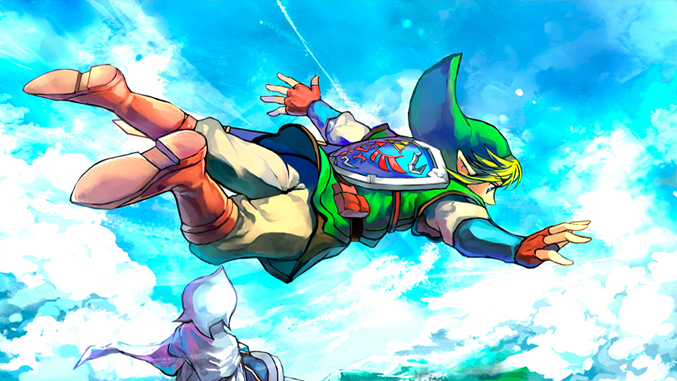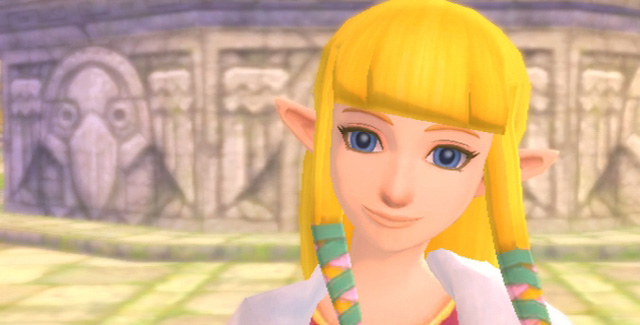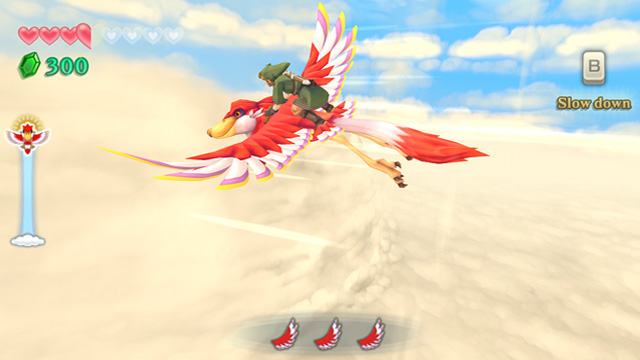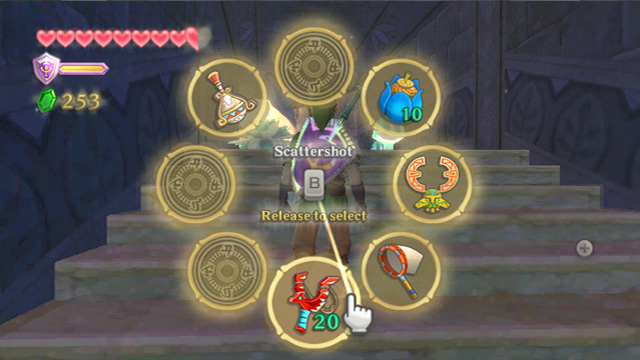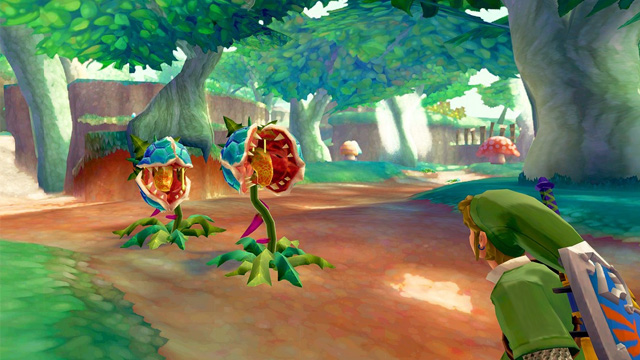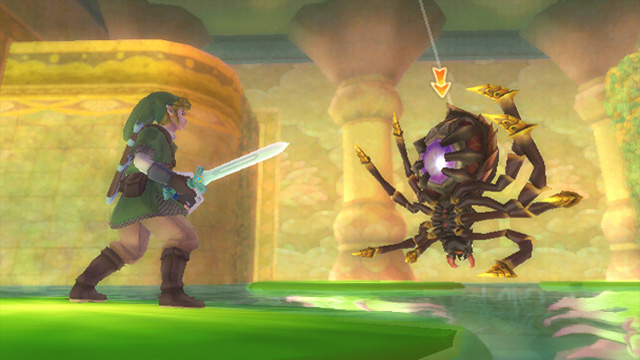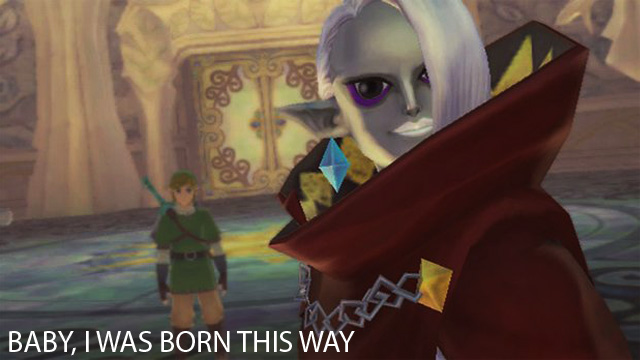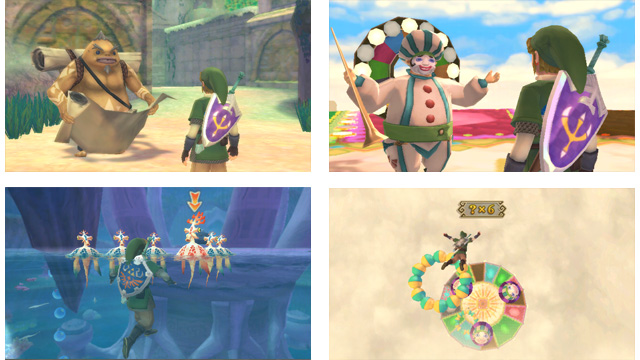The legend of Zelda: Skyward Sword
Release Date: November 20, 2011
Developer: Nintendo
Publisher: Nintendo
Genre: Action / Adventure
Plataform: Nintendo Wii
To criticize about a game so strong and expected as the Zelda series, requires a lot of responsibility on the part of the writer. Of course, anyone can pick up a paper - or in this case a blog! - And write whatever they want, without using foundation or even trying to prove and to invent new reasons to justify his criticism. This does not mean that an analysis is worth more than the other, but what should be taken into account is the responsibility brought along with his words. And it is thinking about this aspect that I start my review on the newest game in the series The Legend of Zelda. This time the long-awaited Skyward Sword. I believe that many may not agree with my opinion here, perhaps taking it personally and not accepting that one can negatively criticize this game in some aspects, but I hope you understand that analyzed not only the side of art, as well as technical aspects.
A friendship in the sky
A letter of Zelda comes to Link early in the game. Unlike expected, is not a distress call from the young princess, but a warning reminding you of the event between both of them. In this new adventure, Link, Zelda and the other characters do not live in the famous land of Hyrule. His new place is called Skyloft, an island that floats above the clouds in the sky. And as a floating city, the whole aspect of art, gadgets and buildings are based upon this concept. The main transport of people are already trained giant birds known as Loftwings. And, of course, the bird of Link is different from the others, causing him to suffer prejudice on the part of the town troublemakers, and compliments on the part of Zelda, her best friend from childhood and, until then, it is not a princess.
It is interesting to note that the timeline between this, with previous games in the series, follows a disordered flow. By the way history is presented, makes you believe that Skyward Sword takes place before the events of Ocarina of Time. No one can say that all games follow a sequence and complete in itself, but somehow if we were put in a timeline, that would be what makes the most sense so far, taking into account that the inhabitants of Skyloft not know the "world below the clouds", and that fear was like hell down there and was just a legend. But of course that is not enough to Zelda. She believes that there is a whole new world down there, and that even the other calling that place of legend, she was always curious to discover and prove their veracity.
Dialogues here, childish taunts there and some disputes in the sky - which is also one of the coolest thing in the game! - While Zelda and Link are talking and flying over their giant birds, a strong whirlwind comes and sucks the girl down there. So Link must leave for his childhood friend and uncover the secrets of the world below the clouds, finally discovering the evil land of Hyrule. To do this, Link meets Fi, a spirit of feminine appearance, created by the Goddess worshiped in Skyloft, which inhabits the sword of Link. She will guide Link on his journey, providing information necessary for its advancement, helping at certain times of the plot.
It is noteworthy that unlike The Wind Waker, which we sailed in a boat, fly in your Loftwing in Skyward Sword can be an amazing experience. To begin the flight speed does not compare to the time it took the boat to cross the oceans. Flying is something magnificent, practical and fun. All control of Link's Loftwing is made with the movements of the Wii Remote. And the feeling of weightlessness for the variation of speed is something that really responds very well. Not to mention how fun it is to run out of the floating island and jump in the clouds, calling your bird with a whistle and flying freely in the sky.
When the Legend evolved
Create a new game for an old franchise requires a lot of the developers, especially when it is considered a legend. What is better? Risk and develop points that have always been well-regarded in the series, but trying to innovate with what is already offered for the new generation, or keep the same rate as the previous games and be sure it will be a good game, but without any great new? Luckily Skyward Sword tries to mix a little of both and can evolve, but without slipping and risking too much. The present developments in the game are rather details that bring a more positive aspect, but it's nothing that really stands out as a great new differential, which finally could have been.
I would rate this new Zelda as an Action / Adventure game with new RPG touches. I say RPG because now this is an evolving system of items and equipment that are based on the collection of other specific materials during the game, such as jewelry, captured insects etc. You have the freedom to evolve what equipment you want and even to have a stronger shield you should evolve it or use one that best suits in the environment you are visiting then, remembering that now shields can break depending on usage unbalanced. Again, I sort as an RPG game because even the narrative of the game in the end of everything just follow the same line, the way everything is presented and the fact that Link remains a "dumb" character, makes this game even more closely matches in the genre. This inclusive, are details that should have been better observed by the creative team. First, why to offer the player a choice of answers that Link could give during the game, if all the answers will lead to exactly the same result, only changing the tone of the conversation? Or, before all the fantastic art direction and soundtrack of the game, why not this time progress and not risk a little more and dub the voices of the characters eventually? Even if that dubbing follow a dialect unique and special, as the character Fi in the game features. Well, these are questions that will be left unanswered for now...
Still treating of the technical side I must confess an initial shock that I had when I play the game in Nintendo Wii. Unconsciously, it comes to the current generation of Video Games, we are frightened when we see graphics that do not correspond with those of recent games. My first impression to start playing Skyward Sword was that something was wrong with my television. The graphics did not look beautiful, the textures are presented in low resolution and jaggies, wow, how many jaggies! But I can guarantee that after 20 minutes your whole outlook changes and the game begins to convince you perfectly, because you see a great affection in every little detail of the scenarios, colors, art direction, great level design and creativity with everything. The game features a color palette to envy others. Combining this with superb soundtrack managed by Koji Kondo, we can't criticize the game and not drooling for each new second. In my opinion, is definitely the best soundtrack of the game series The Legend of Zelda.
As we are talking about technical developments, another major difference is the new gameplay that the game presents. Attacking using Link's sword is now much more fun. Finally, with the help of the Motion Plus, the game has more accurate controls - as far as possible! - Ensuring that the movement of the sword will follow the same direction and angle that you do holding your Wii Remote with your hands. The feeling of lifting your Wii Remote over your head and see Link doing the same movement while charging the energy of the sword is amazing. Cuts are allowed horizontal, vertical and diagonal from left to right or vice versa, while the Nunchuck is responsible for the control of the shield on the other hand. And the coolest part of all this is that "with great power, comes great responsibility" and, therefore, the enemies have different strategies to combat them, which vary for the position that they defends or attacks. In fact, in the case of a difficulty curve, I found that the Skyward Sword has the greater initial difficulty in Zelda games series. I emphasize the word "initial" because although the game begins with a difficulty curve strengthened, everything ceases to exist going forward. Despite going Dungeons becoming increasingly complex, lengthy and at times even boring, the bosses in the end of each Dungeon possess a decreasing level of difficulty, which is unsatisfactory.
The Goddess Oracle
During the search for Zelda in the World below the Clouds, Link comes across another character that is also behind the girl, in which he refers to as the Oracle of the Goddess. The character, known as Lord Ghirahim, is the villain of the game and aims to resurrect their master, and for that, somehow need Zelda.
Lord Ghirahim can be one of the MOST BIZARRE villains of all time. Possessing feminine traits, haircut "trendy" and clothes that seem to have gone out of the closet of Lady Gaga leave it even stranger. The objectives of the villain are not fully disclosed at the beginning of the game. All we know is that Zelda is one of the chosen and possess a very vital role for both the Goddess and to generate enough energy to revive the great master of Ghirahim. So besides having to go in search for Zelda and understand everything that is happening, Link must also be present in time to protect the girl from the surprise attacks of Lord Ghirahim.
One of the sacred objects in Skyward Sword and that inclusive is Zelda that handling early in the game, is the Harp of the Goddess. It would be the equivalent of Ocarina in Ocarina of Time. During the game you also learn to play different songs on the harp, and the entire command is controlled by the Motion Plus, simulating the motion of strumming.
The Hero's Journey
Throughout all his journey and his goal of save her best friend Zelda in the World below the Clouds, Link begins to realize that there are more secrets than he could imagine. He realize that Zelda also has a mission and it will not give it up until she finish her goal, regardless of the new danger that she is running. New alliances are emerging, proving that Link is not alone in this. But to achieve your next step, the energy of the Triforce is put into practice again, forcing our hero to find within you the Strength, Courage and Wisdom enough to be able to complete this additional challenge.
While I analyze in a positive point the way that Triforce is presented in Skyward Sword, showing that Link must earn that power to move on, there is another point that disappointed me a little and added a lot of negative way for the progress of history, which is the repetition.
Okay, this new Zelda is probably the largest Zelda Game ever launched before. The total time of the game is huge if you complete all the goals and extra check for all items, and even then only if the linear narrative of the game duration is also very rewarding. However, there are several completely unnecessary moments or ways that developers justified to extend the plot. If you are one of the players that, for example, didn't like the forced repetition of the game Folklore (PS3) in return for their game scenarios, you end up feeling uncomfortable about it around here too.
After completing the initial and main Dungeons in the game to finally get to earn and acquire the power of the Triforce, Link must travel again for each of the Dungeons and achieve what is asked in the game. Of course, the scenarios change in some respects, but nothing like it so much that the players need to "recycle" level designs that at first impression, was seen in a good way. The obligation to follow the same steps again, give to Skyward Sword a downside to the game.
Still, even with some technical problems, repetitions or even that feeling that could have been a game more evolved compared to previous series, The Legend of Zelda: Skyward Sword can stand well with an impeccable art direction, a level design to let anyone open mouth, and keeps on top, or rather, above the clouds, proving once again that the LEGEND remains as a Legend.
My Personal Score: 3,5/5
[button type="icon" icon="paper"]Written by Matheus Pitillo.[/button]

